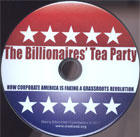
The Billionaires’ Tea Party: How Corporate America is Faking a Grassroots Revolution 2010
Distributed by Media Education Foundation, 60 Masonic St., Northampton, MA 01060; 800-897-0089
Produced by Larrikin Films
Directed by Taki Oldman
DVD , color, 57 min.
College - General Adult
American Studies, Business, Political Science
Date Entered: 11/30/2011
Reviewed by Michael J. Coffta, Business Librarian, Bloomsburg University of PennsylvaniaAustralian filmmaker, Taki Oldman, examines the Tea Party phenomenon in the United States, purporting that the movement is chiefly and covertly motivated by and funded by elite corporate interests. The film does an excellent job of charting the evolution of this movement, beginning with the libertarian party’s run in the 1980 Presidential election, steered and funded by industrialists Charles and David Koch. Oldman cites and explores significant milestones in the group’s development, including Rick Santelli’s “rant" (as it has been coined), the Tea Party Declaration, and the inertia the movement gained after Obama’s election.
Oldman gives evidence for his three indictments: (1) the movement is not a true grassroots movement, but one supporting a radical form of capitalism, (2) it is largely based on propaganda, and (3) it is gaining media support. While the movement veils itself in issues such as debt reduction and fighting government corruption, Oldman argues that Tea Party groups systematically target pro-corporate causes, such as healthcare and environmental legislation. He dissects the information dissemination practices that play upon fears, such as stripped healthcare, while demonizing anti-capitalists. He examines the Tea Party’s media outlets, and argues that several mainstream news sources support this cause. Oldman goes to a rally incognito, to reveal some of the rhetoric.
This film provides an excellent investigation of strategy and tactics of the Tea Party. It unapologetically displays the mania of a selection of the movement’s advocates. Clearly, there is no balancing with countering evidence, but this work does advance its thesis with volition. The clearest value of this film is its thorough research into the splinter groups and think tanks that comprise the Tea Party phenomenon. The Tea Party is not a political party, proper, but a series of loosely unified entities. With a graphic very much like an organized crime tack board of the FBI, Oldman exhibits both the evolution of the movement and its rising influence through a myriad of organizations. Last, viewers should also note that there is a small dose of foul language at one point in the film.